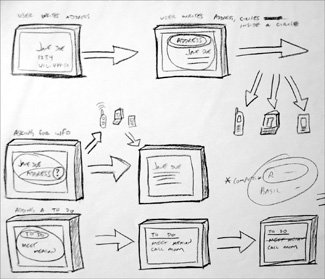Sketches and Models
| Of course, designers can sketch with images as well as words (Figure 5.9). As stated earlier, the designer's best tool has been and continues to be the physical drawing surface (paper, whiteboard) and the physical drawing instrument (pencil, pen, crayon, marker). Nothing digital thus far has been able to match the flexibility, speed, and ease of sketching on a piece of paper or whiteboard. Space is just one reasoneven the largest monitor cannot compete with wall-sized whiteboards or sheets of paper fastened together. Figure 5.9. Sketching is an essential design tool.
Another form of sketching is modeling. Models can be made of a variety of materials, from clay to cardboard to Styrofoam. Large blocks of Styrofoam can even be used to model physical spaces. Even crude blocks of wood, like those carried around by Jeff Hawkins to test the size, shape, and weight of the original Palm Pilot, can be models. Models, like sketches, can be rapidly put together in a short period of time to give rough approximations of physical objects and environments. Sketching and modeling should be done throughout the design process, of course, but they are most helpful as visualizations of concepts and ideas that are still being formed to help to clarify and communicate those ideas and concepts. Sketches and models are, by their nature, informal, and they can be easily changed. Viewers feel free to comment on them for just this very reason. This is a good thing, and no designer should feel overly attached to them. |
EAN: 2147483647
Pages: 110
- Article 314 Outlet, Device, Pull, and Junction Boxes; Conduit Bodies; Fittings; and Handhole Enclosures
- Article 322 Flat Cable Assemblies Type FC
- Article 353 High Density Polyethylene Conduit Type HDPE Conduit
- Article 410: Luminaires (Lighting Fixtures), Lampholders, and Lamps
- Example No. D2(a) Optional Calculation for One-Family Dwelling Heating Larger than Air Conditioning [See Section 220.82]
